Within and cross-sensory interactions in the perceived attractiveness of unfamiliar faces
引用次数: 0
Abstract
Major findings in attractiveness such as the role of averageness and symmetry have emerged primarily from neutral static visual stimuli. However it has increasingly been shown that ratings of attractiveness can be modulated within unisensory and multisensory modes by factors including emotional expression or by additional information about the person. For example, previous research has indicated that humorous individuals are rated as more desirable than their non-humorous equivalents (Bressler and Balshine, 2006). In two experiments we measured within and cross-sensory modulation of the attractiveness of unfamiliar faces. In Experiment 1 we examined if manipulating the number and type of expressions shown across a series of images of a person influences the attractiveness rating for that person. Results indicate that for happy expressions, ratings of attractiveness gradually increase as the proportional number of happy facial expressions increase, relative to the number of neutral expressions. In contrast, an increase in the proportion of angry expressions was not assocated with an increase in attractiveness ratings. In Experiment 2 we investigated if perceived attractiveness can be influenced by multisensory information provided during exposure to the face image. Ratings are compared across face images which were presented with or without voice information. In addition we provided either an auditory emotional cue (e.g., laughter) or neutral (e.g., coughing) cue to assess whether social information affects perceived attractiveness. Results shows that multisensory information about a person can increase attractiveness ratings, but that the emotional content of the cross-modal information can effect preference for some faces over others.感知陌生面孔吸引力的内部和跨感官互动
关于吸引力的主要发现,如平均和对称的作用,主要来自中性的静态视觉刺激。然而,越来越多的研究表明,吸引力的评级可以在单感官和多感官模式下通过情绪表达或有关该人的其他信息等因素进行调节。例如,先前的研究表明,幽默的人比不幽默的人更受欢迎(Bressler和Balshine, 2006)。在两个实验中,我们测量了不熟悉面孔的吸引力的内部和跨感官调节。在实验1中,我们检验了在一系列人物的照片中操纵表情的数量和类型是否会影响这个人的吸引力评级。结果表明,对于快乐的表情,相对于中性的表情,随着快乐面部表情的比例增加,吸引力的评分逐渐增加。相比之下,愤怒表情比例的增加与吸引力评分的增加无关。在实验2中,我们研究了在暴露于人脸图像时提供的多感官信息是否会影响感知到的吸引力。评分是通过带有或不带有语音信息的面部图像进行比较的。此外,我们提供了听觉情感线索(如笑声)或中性线索(如咳嗽)来评估社会信息是否影响感知吸引力。结果表明,关于一个人的多感官信息可以提高吸引力评级,但跨模态信息的情感内容可能会影响对某些面孔的偏好。
本文章由计算机程序翻译,如有差异,请以英文原文为准。
求助全文
约1分钟内获得全文
求助全文

 求助内容:
求助内容: 应助结果提醒方式:
应助结果提醒方式:


